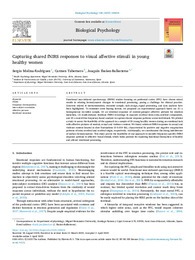Título :
Capturing shared fNIRS responses to visual affective stimuli in young
healthy women |
Autor :
Molina Rodriguez, Sergio
Tabernero, Carmen
Ibañez Ballesteros, Joaquín |
Editor :
Elsevier |
Departamento:
Departamentos de la UMH::Fisiología |
Fecha de publicación:
2025 |
URI :
https://hdl.handle.net/11000/36810 |
Resumen :
Functional near-infrared spectroscopy (fNIRS) studies focusing on prefrontal cortex (PFC) have shown mixed
results in relating hemodynamic changes to emotional processing, posing a challenge for clinical practice.
Concerns related to instrumentation, recruited sample, task design, signal processing, and data analysis have
been highlighted. To minimize some biasing factors, we proposed an experimental approach based on: (1) a
homogeneous recruited sample, (2) an identical sequence of content-grouped affective pictures for emotion
induction, (3) multi-distance forehead fNIRS recordings to separate cerebral from extra-cerebral components,
and (4) a model-free frequency-based analysis to capture shared response patterns across individuals. We piloted
a study to assess the feasibility of the approach in a sample of 20 young healthy women during an emotional task
with affective pictures of neutral, sexual and violence content. We found coherent fNIRS responses to sexual and
violence content located in slow fluctuations (0–0.019 Hz), characterized by positive and negative oxygenation
patterns of extra-cerebral and cerebral origin, respectively. Additionally, we corroborated the strong interference
of surface hemodynamics. This study proves the feasibility of our approach to identify frequency-specific fNIRS
response patterns to affective visual stimuli, which holds promise for exploring functional biomarkers of healthy
and altered emotional processing.
|
Palabras clave/Materias:
FNIRS
Frequency decomposition
Inter-subject correlation
Affective pictures
Emotional responses |
Área de conocimiento :
CDU: Ciencias aplicadas: Medicina: Fisiología |
Tipo de documento :
info:eu-repo/semantics/article |
Derechos de acceso:
info:eu-repo/semantics/openAccess
Attribution-NonCommercial-NoDerivatives 4.0 Internacional |
DOI :
https://doi.org/10.1016/j.biopsycho.2025.109024 |
Publicado en:
Biological Psychology 196 (2025) |
Aparece en las colecciones:
Artículos Fisiología
|
 La licencia se describe como: Atribución-NonComercial-NoDerivada 4.0 Internacional.
La licencia se describe como: Atribución-NonComercial-NoDerivada 4.0 Internacional.
.png)
